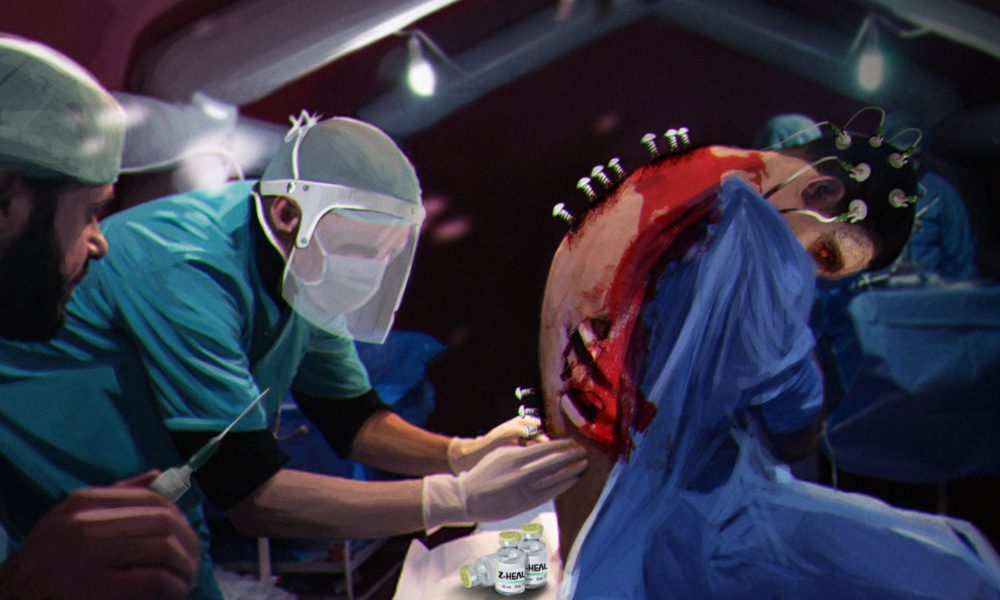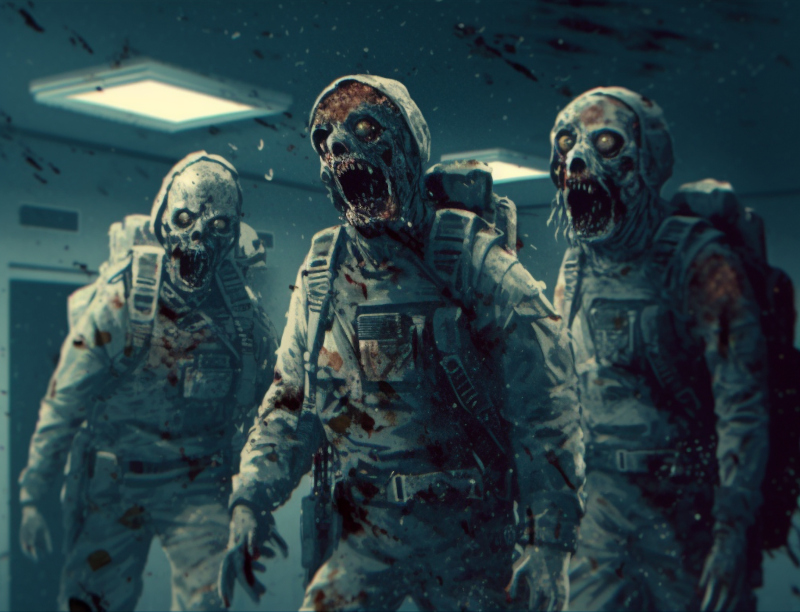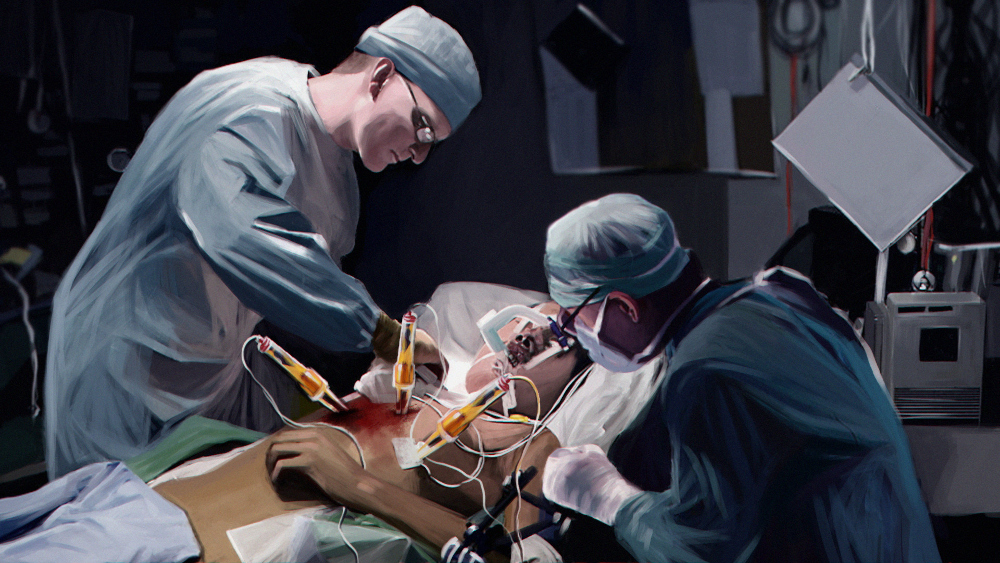Disease X

Disease X first appeared during the last war. At that time, it was simply called Disease X. No one could determine whether it was a natural virus or a potential biological weapon.
Due to the evacuation of Earth, Disease X was not significantly studied with the scientific capabilities of the time. If it was, the information was likely forgotten, just like many other aspects of life on Earth.
Currently, we know only a few basic facts, and there are several theories that divide humanity into factions based on different beliefs.
Disease X is a highly contagious disease, first recorded at the end of the Earth era. It affects both humans and most known fauna. It is primarily manifested by a loss of control, hallucinations, extreme aggression, and eventually leads to coma and death.
The disease is incurable, and any contact with the infected inevitably leads to death. Current medicine can only try to delay and suppress the consequences of infection.
Identifying the infected in the population before the disease progresses to its final stage is nearly impossible.
Cult
The Cult does not believe in the biological origin of the disease and seeks connections between the infection and demonic possession. They directly associate it with sin. The infected are not considered ill but unclean, and are immediately removed from society after the first signs appear.
Practices vary depending on the space stations, but bodies of the infected are often burned or ejected into space via an airlock, where no accumulation of bodies threatens the station.
The Cult uses rituals in station shrines to uncover the infected. During these rituals, some infected individuals display a loss of control, consciousness, or aggression. Such individuals are usually quickly removed by an armed patrol.
The Cult does not deny the contagious nature of the disease but attributes it to the impure mental nature of humans. Therefore, they do not use other hygiene measures other than separating the infected from the rest of the "pure" population.
As the established view on the disease, they prefer The Theory of Divine Fate.
Humanity
Followers of Humanity believe that the infection originated on Earth. It was most likely brought to the stations at the very beginning of the space age by humans leaving Earth due to this disease. They assume that the disease had been latent or unnoticed in the population for many generations and has only now significantly spread.
They prefer the Prion Theory as the main explanation for its origin and spread.
Efforts to research or treat the disease are experimental and random, as humanity lacks sufficient technical and scientific infrastructure after fleeing Earth. There is no systematic research in present society to uncover these mysteries.
First Appearance in the Space Age
The first contact with the disease occurred on a now non-existent station, whose name is classified for historical reasons.
An unknown organism, roughly the size of a living compartment, with tentacles and claws, was observed on the station's outer hull. It perforated the station's hull, was undetected, and the subsequent decompression caused the station to crash onto the surface of Earth.
Several colonists escaped using rescue modules. There is factual evidence suggesting that these survivors somehow influenced the crews of other stations and caused a new outbreak of Disease X. This series of events is considered a milestone in the new outbreak of Disease X.
Protection against "Parasites," as they were later called, is now routine on every station.
Useful Insights
 Stabilized patient after battling Disease X.
Stabilized patient after battling Disease X.Disease stabilization was achieved with the help of an implanted device in the early stages. Astronauts can infect each other depending on the duration of contact and proximity. Those sharing a workspace on the ship can infect each other. The station crew will be infected if astronauts without assigned workstations exit a docked ship. Robots are unlikely to be carriers of the disease.
Black Liquid stored on the station triggers the outbreak. It is unclear whether the disease is hereditary, but it is difficult to prove that the offspring was not infected by the parent. Resistance to infection affects the likelihood of infection and the duration of the stages.
Stages of the Disease
The disease has several stages:
1 Latent Stage
In this early stage, individuals are potentially infected, but the disease is still nearly undetectable clinically. The first symptoms are subtle, and diagnosis is difficult. The disease can still be transmitted, although the infected individual shows no obvious signs. Gradually, they begin to release infectious substances into the environment, posing a risk to others.
2 Outbreak
Outbreak represents a radical change in the infected individual's behavior. Within moments, they lose control of their actions and begin exhibiting signs of extreme aggression and self-destructive behavior. During this phase, the infected are referred to as being in the "active phase" or, in the Cult's terminology, "damned." They may attempt to attack others and spread the disease, using their limbs and teeth. Their behavior is dangerous and often deadly for others.
3 Active Phase / Damnation
 Outbreak in the crew's living quarters.
Outbreak in the crew's living quarters.This phase is characterized by extreme aggression and self-destructive behavior of the infected. These individuals are commonly referred to as "Zombies." They lose the ability to feel pain or injury, but their strength and resilience increase. They can survive in extreme conditions, with no need to eat, sleep, or breathe. Defense against them often requires the use of firearms.
4 Treatment / Stabilization
 Progression of stabilizing the infected, administering stabilization substance Zheal.
Progression of stabilizing the infected, administering stabilization substance Zheal.Disease X is not treatable at any stage, but with the help of an implanted device in the early phase, the aggression of the infected can be suppressed. Stabilized individuals are referred to as "Ghouls." Although their consciousness and judgment return, part of their enhanced physical abilities remain. The Cult still considers them "damned" and forbids sharing a ship or station with them. This stage allows the infected to survive, but they are still considered dangerous.

